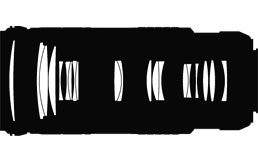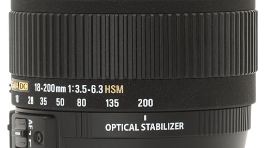Photography Lenses
First, note that ordinary compacts and bridge cameras do not take extra lenses (although some might have additions to the lens already there). So this advice applies to Compact System Cameras and DSLR’s. If you are confused between ‘Compact’ and ‘Compact System’ cameras please refer back to the Camera page.
Lens bodies have a complex arrangement of lenses inside them – note the glass lenses shown in white in a Nikon DSLR zoom lens below:
DSLR Lenses
DSLR manufacturers tend to produce their own lenses but there are also cheaper third party production the best regarded being Sigma and others are Tamron and Vivitar. Often your camera will come with a lens included – at the entry level end they are usually 18 – 55 mm and tend to be thought of as body protectors since the quality low. A few positive points things – they are cheap (since included), they really do function well as body protectors, and you won’t notice the low quality until you upgrade to another lens. Lastly they give you a chance to practice with a zoom lens.
If you already have lenses then you might prefer to buy a camera body only. The most expensive cameras usually come with better lenses included. Beware of deals that throw in a lot of lenses – you need to think about Image Stabilization on any long zoom lens – and make sure the lenses are a known make.
The main difference in lenses is between fixed focus and zoom lenses. We recommend you start with a zoom so you can get a feel for different distances. Fixed lenses are better quality because they only do one thing.
Prices go up a lot for faster lenses (meaning a lower wide open aperture number e.g. F1.4 would be very expensive as compared to F4).
browse a range of DSLR Lenses on amazon
Micro 4/3 lenses – (also called MFT )
Lenses for Compact System Cameras will be smaller the DSLR lenses (as are the cameras) and they can be called compact system or micro four thirds lenses or have their own special lens range (e.g. Nikon V1). Be aware that the range offered will be restricted compared to the vast lens range for DSLR’s and they may also be relatively more expensive. If you go for micro four thirds lenses then they work on both Panasonic and Olympus compact system cameras but as with DSLR’s Nikon lenses work on Nikons and Canon work on Canons etc. Ordinary four third lenses will also work on micro four thirds but will look and feel hefty.
What is the four thirds system ? This is a proportion 4:3 as opposed to the usual 3:2 – some people find this more pleasing.
Note that you are not stuck with this shape since you can set it to 3:2 and other proportions if you wish, but there will be less than optimum use of the sensor size. Usually four thirds sensors are smaller than those on DSLR’s (as shown roughly above).
browse a range of Micro Four Thirds Lenses on amazon
Fast and Slow lenses.
A fast lens lets in more light so is useful for low light situations and means you can get higher shutter speeds as a result so they are useful in the UK winters and necessary for Sports Photography in particular. A fast wide ranging zoom lens could cost you thousands more than a slightly slower one for the same zoom range. A lens is fast or slow according to the widest F number quoted – a fixed lens will have just one widest F number and a zoom lens will usually quote two (one for zoom out (widest angle) and one for zoom in – long end will let in less light so it will have a higher F number than the wide end. If a zoom lens has the same F number throughout the range you will pay a lot for it.
In the 18 – 200 mm lens below, the wide F number is 3.5 and when zoomed in it is 6.3 – on the lens below it says 1:3.5-6.3 .
To summarize low F-numbers here are good and let in more light but are more expensive.
browse top of the range Lenses at Amazon
<<Back Camera Guide Next >> Guide to Extras



